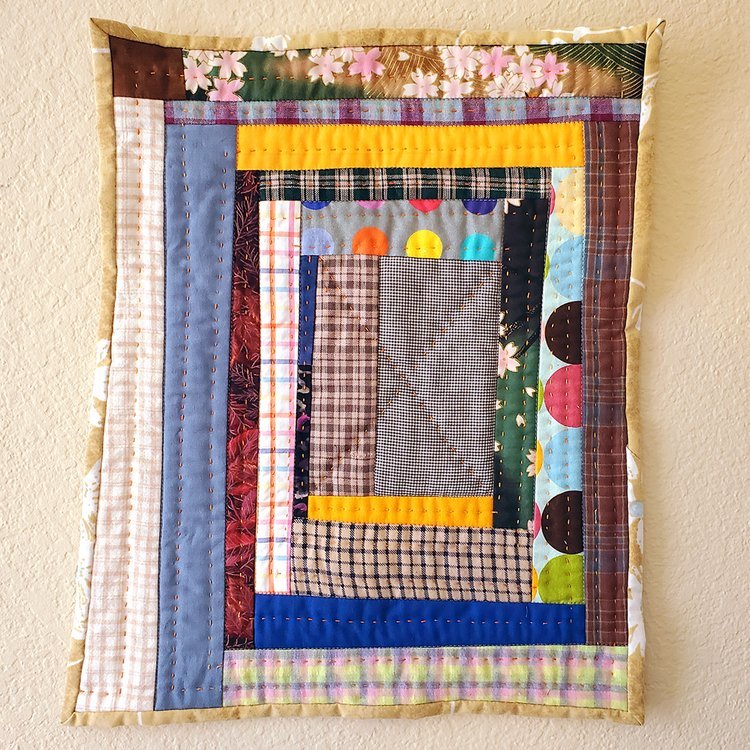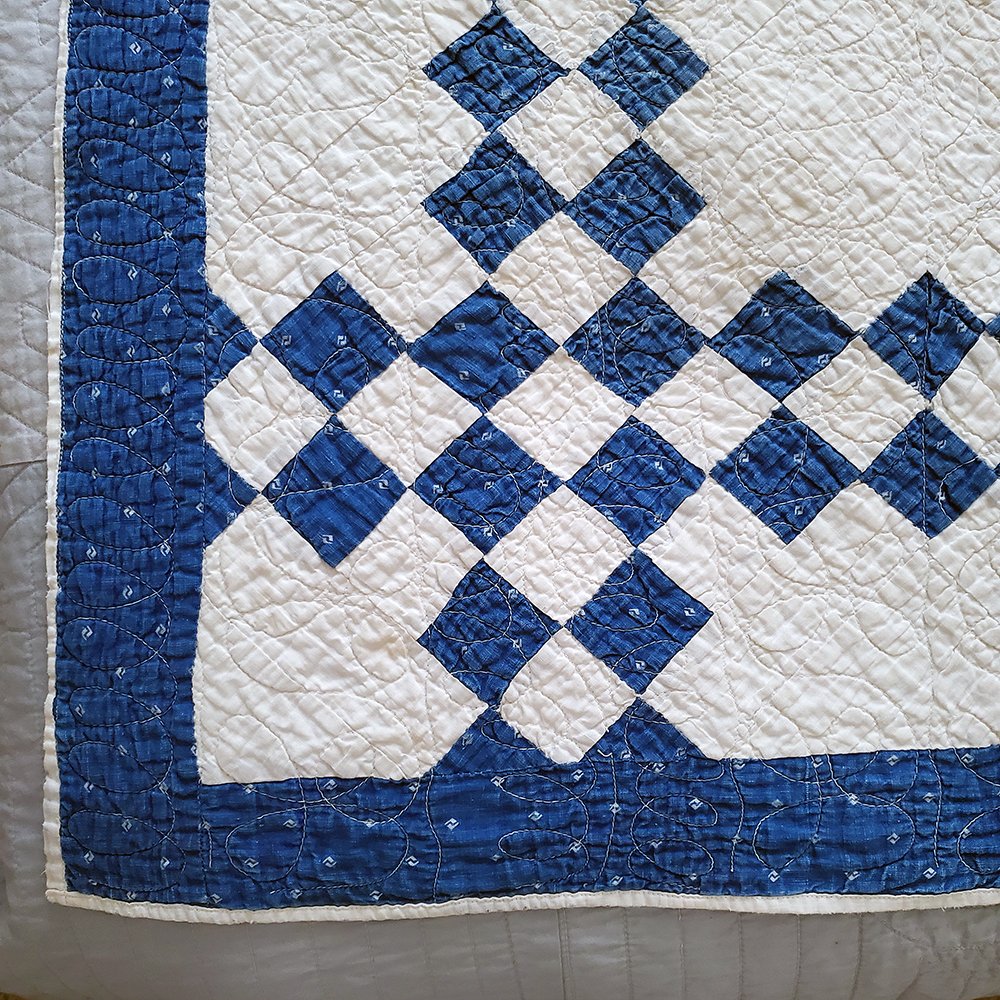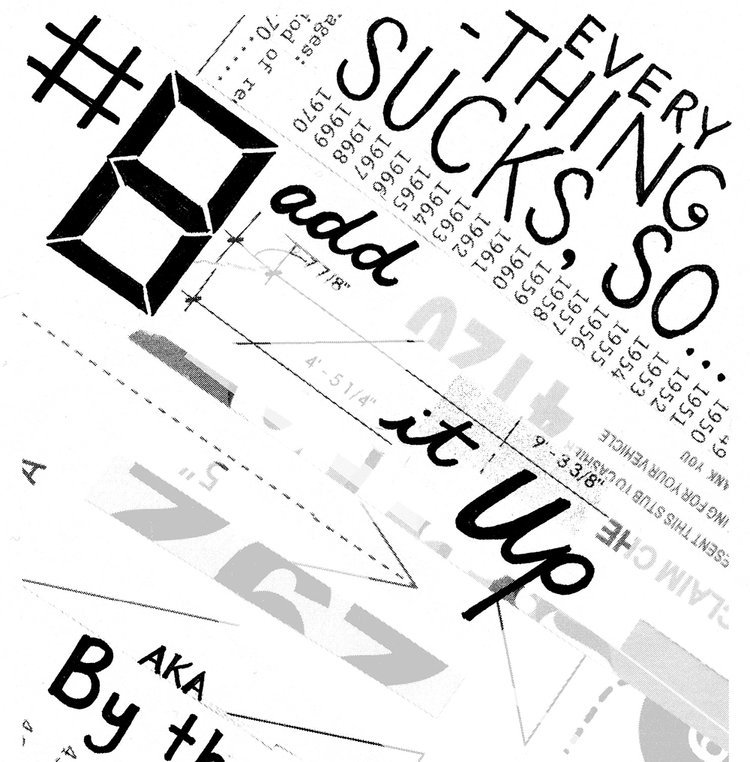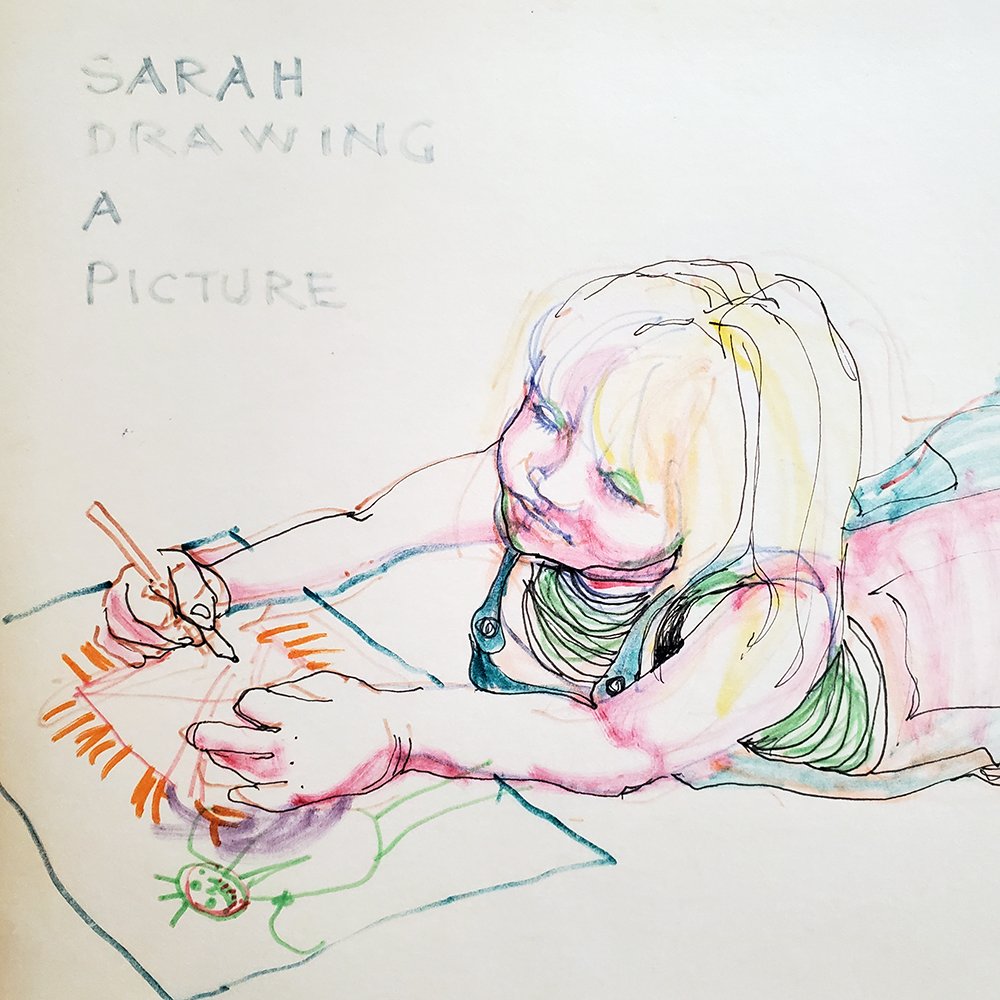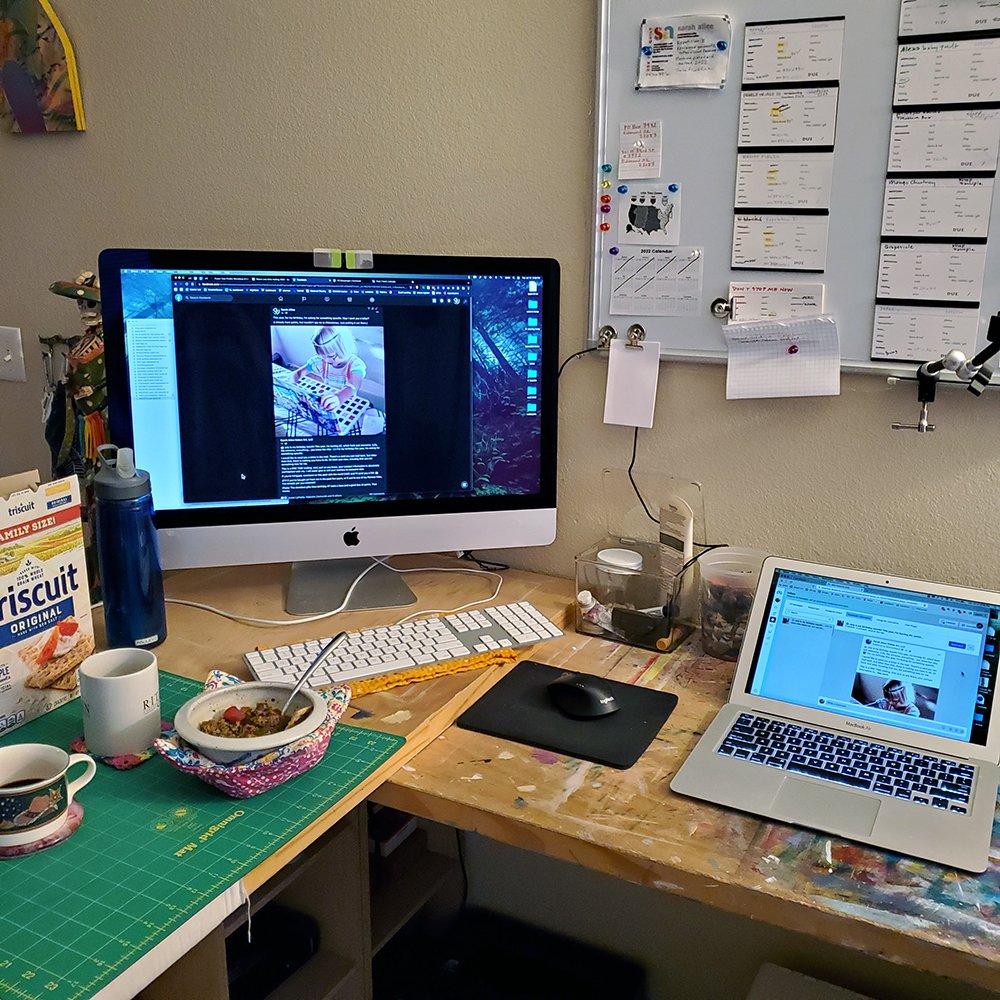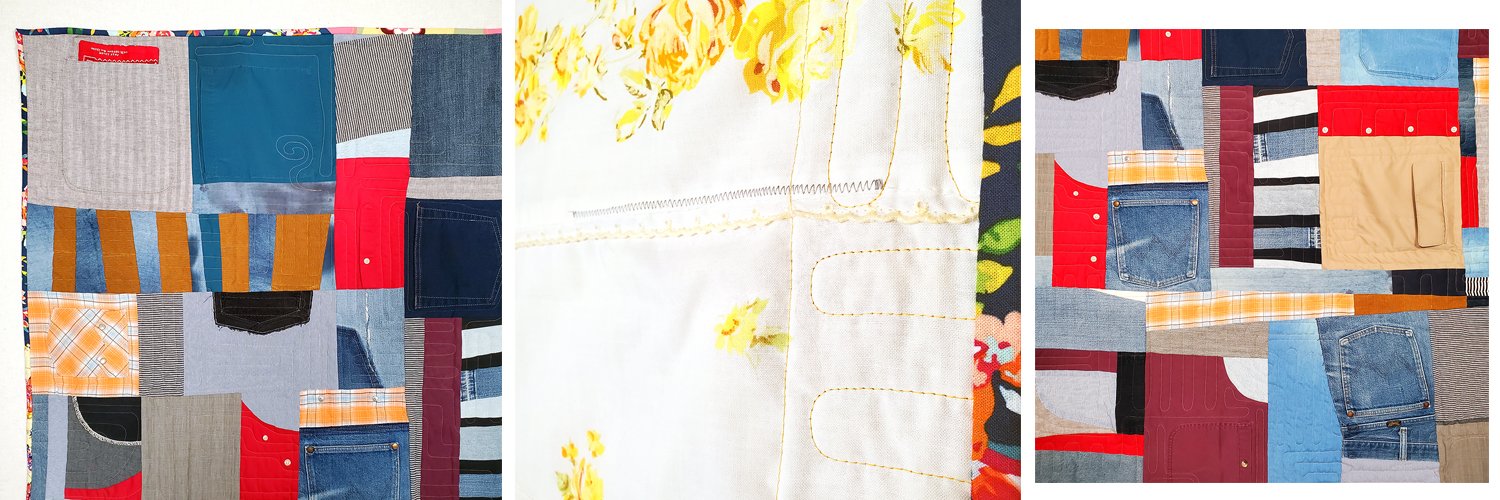It's About Surrender.
"To be is to be perceived. And so to know thyself is only possible through the eyes of the other. The nature of our immortal lives is in the consequences of our words and deeds that go on apportioning themselves throughout all time." Sonmi451 / Cloud Atlas by David Mitchell
Head, Shoulders, Knees and Toes (Knees and Toes)
Do you do yoga? I practice sometimes. I first tried it in college (where my $cholar$hip paid for classes!). My favorite asana has always been the forward fold.
"Uttanasana" translates roughly to "intense stretch pose," but for me, it's about surrender. I surrender to gravity. I surrender to the reality of my body that day. I surrender the desire to make a perfect shape, surrender to imperfection. I surrender my thinking mind to my physical senses. To stillness, non-doing. And I love the journey, from all-the-way-up-there to all-the-way-down-here.
What have you surrendered lately?
A Soft Place To Land
A Soft Place To Land. Cotton fabrics, 13x15.5 inches
Machine pieced and quilted with additional hand quilting
$368 Update: This piece has gone to a loving home.
This is a small wall-hanging quilt I recently made, in response to a thought-work exercise with Kyla Mitsunaga, aka the Asian Auntie You Didn't Know You Needed. I'll tell the whole story another time, but this piece is about surrender.
I surrendered to some scary thoughts, deeply embedded in my subconscious. I let them come to the surface, which felt like momentary freefall. With Kyla's help, I gave them a safe, soft place to land. This experience is already giving rise to a new series. A Soft Place To Land is the first iteration.
The Cutter
I have a quilt on my bed that's about a hundred years old. This is useful for several reasons.
1. It's warm. People sometimes ask me why the quilts they remember from childhood are warmer/heavier/cozier than quilts today. That may be partly nostalgia, but wool and cotton battings were much more common in previous decades. Now quilt battings are usually polyester or a cotton/poly blend.
2. It's beautiful. We musn't dismiss the utility of beauty.
3. This quilt was made with a technique unusual for the time. My friend Martha (a quilt collector who sold me this piece) told me that the quilting is freemotion, but it was done on a treadle machine. Now, if you're a quilter, your eyebrows are likely raised. Freemotion quilting is how you make loop-de-loops and pretty much any design besides straight lines. This is easy with a longarm quilting machine, and with some domestic machines (depending on the quilt's size), but I struggle to imagine getting this done on a treadle, especially considering the consistency of the stitches. Wowza.
[Why isn't this quilt being kept under archival conditions? Because some of it looks like this:
And some of it looks like this:
In the industry, this is called a "cutter."]
4. My favorite thing about this quilt: It has a history. And - this is crucial - I don't know what that history is. I only know what's happened since I saw the quilt at Martha's garage sale. Previous chapters are closed to me.
Here's why that matters.
Did you read the book or see the movie Cloud Atlas? The narrative is structured around big time jumps and seemingly unrelated characters. But it's all connected. Because no one knows what part of your life is going to go on existing after you're gone. You could be a lawmaker or a tycoon or a research scientist and your contributions to future generations might be obvious. But most of us don't know what our legacy will be. It's out of our control. We have to surrender.
Creators are often preoccupied with the idea of legacy. We are surrounded by messages telling us who to be, how to be, how to ensure our efforts make an "impact" in an atmosphere of noise. It's a lot of pressure. By choosing to acknowledge our very limited control, we can find freedom.
I don't know who made the quilt on my bed. There's no label on it. (FYI: Label your quilts!!) The maker was probably a woman. So I'll tell her now: Dear Ms. Quilter, Somehow your quilt made it into my hands, and I appreciate what you created. Thank you.
Everything Sucks, So... issue #8!
It's a good time to order the latest issue of the ESS zine. Why? Because issue #8 (Add It Up, aka By The Numbers) is the last one. For now, anyway. I started this zine as a pananoramadingdong project and I feel that it has served its purpose. Issue #8 is available now in my web store. Back issues of ESS (both paper and digital editions) will remain available as long as y'all keep buying them, whether that's through my website or in OKC at DNA Galleries or Literati Press Bookstore. Thank you for coming with me on this journey.
Thanks for reading!
Want more in-depth stories, sprinkled with links, delivered to your inbox? Sign up for The Fold. (Check your email and spam folders for the confirmation.) There's a free gift in it for you!
You can also find me at Facebook, Instagram, Pinterest, LinkedIn, and Twitch.
My Hand Sewing Kit
I've just delivered a stack of newly finished quilts to a professional photographer. To get ready for that delivery, I spent most of last week sewing labels and sleeves onto quilts. That's a lot of time hanging out with my hand sewing kit.
How about a little tour? It really does all fit into that mini metal lunchbox pictured above. (Except for those two spools of thread. Choices were made.)
Top row, L-R: Needle threader (unused), sake cup pincushion with pins and wonderclips clipped around the rim; Liberty of London pincushion for backup pins (made by my friend Elizabeth)
Row 2: Scissors, spools of thread in various weights
Row 3: 2 bobbins with more thread (I try to keep a range of light to dark colors handy), lip balm*, hand balm, heavier threads for hand quilting, measuring tape
Row 4: Bandages (not so much for stab wounds, but for when my fingers get too sweaty), mini-mint tin with needle grabbers, sticky thimble patches, and other aids, adorable needle holder that looks like lipstick, another needle grabber, one button, magnetic needle minder, roll of washi tape, thimble (unused), backup scissors, one paper hexie
* Lip and hand balm because who wants to get all snuggled in to their hand sewing nest with the tv on and realize oh crap, my skin is dry, I have to get up to get the stuff? No one, that's who.
Here's a closer look at my beautiful sake cup pincushion. (I think the cup was made by Ty Illgen, please correct me if I'm wrong.)
What's in your sewing kit? More importantly, why do you keep it in a cookie tin? :)
The Thing You Just Knew You Could Do
Image: Sarah drawn by Sarah's Mom, circa 1984
Remember when you were a kid and when you saw someone do something, you thought, “I can do that, too?” And then you just DID it, in your kid way? That hopefully didn’t result in serious injury? :) What was that thing for you?
I remember an episode of Reading Rainbow that showed a person playing a Koto. (I’ve already gone down the Youtube hole looking for this episode, I think it’s s05 e04, “The Paper Crane.” Here's a different video example.) I gathered up an empty shoebox, paper cups, and rubber bands. I wrapped the rubber bands around the shoebox, using the paper cups as bridges. Then I put paper clips on my fingertips and plucked away at my instrument. And then it was time for dinner.
I haven’t always been that confident. But as an improvisational quilter, I keep that YES sign turned on. I learned to apply the “Yes, and” mentality to quilting from Sherri Lynn Wood. If that sounds familiar, it’s a principle of improv theater as well. In my studio, the conversation is usually, “What if I did ____?” followed by “YES. DO IT.”
Try saying "Yes, and..." to something today.
---
Thanks for reading!
---
Want more in-depth stories, sprinkled with links, delivered to your inbox? Sign up for The Fold. (Check your email and spam folders for the confirmation.)
---
You can also find me at Facebook, Instagram, Pinterest, LinkedIn, and Twitch.
The Business Tool No One's Talking About
A recent photo of my work table, showing a social media post that I composed in a plain text editor. Yes, the Triscuits are important. Never blog on an empty stomach.
tl;dr: Get yourself a plain text editor. You probably already have one.
Google docs. Sticky notes. Voice memos. Notebooks. It's a lot to keep track of. Don't you feel frustrated when you have a great idea, put it somewhere, and can't find it later? Ever write a killer blog post and click Publish, only to see an error message along the lines of "Oopsies, our bad, now your post no longer exists ha ha ha"? Ugh.
I’m not a programmer, or a novelist, or a journalist. But I do a lot of writing in the course of my work as an artist.
I compose all of my blog posts, social media posts, and even some emails in a plain text editor.
Not Word. Not OpenOffice, Google Docs, or any other text-capturing software. Not rich text. Plain text.
Why?
1. No weird formatting or metadata. Have you ever tried to copy a letter or outline from Doc to Word to PDF and had the spacing come out all wrong? Did you get up this morning thinking, "I want to fight with Microsoft Word about what is and isn't a headline"? Even copy-pasting "as plain text" isn't 100% reliable between platforms. Plain text is free of formatting, other than line breaks. When I compose in a plain text editor, then copy-paste to the text's final destination, I know I'll have the formatting under my control.
2. No bells or whistles. Sometimes I just need to write. I don't want to distract myself with fonts, line spacing, kerning, and all the things that make my document pretty, but should wait until after I'm done getting the words out. If I'm trying to write and I see a notification, popup, etc., my train of thought is derailed.
3. No vanishing acts. I use BBEdit on my Mac desktop and laptop computers. I save the files locally (see 3a). If my internet connection gets interrupted, my text doesn't disappear.
It's worth noting that I'm a ten-finger typist. I'm not great at writing on my phone. And while voice-to-text is getting better all the time, it still has a noticeable margin of error. So I prefer to write using a keyboard. (When I’m not scribbling on paper, that is.)
3a. My files are stored locally. I'm just not super comfortable with cloud-based storage. If that's a great solution for you, awesome. I prefer knowing that I can access my text files while offline.
BONUS: this makes it easy to recycle content from my archives!
I do back everything up; I use Time Machine for local backups and Backblaze for offsite.
4. A plain text editor is lightweight. No bloatware here. Text files (with the extension .txt) take up no space at all. It's easy to email them, put them on flash drives, etc.
5. Plain text is easily transferrable, for all the reasons I've listed here. I publish content on a variety of platforms, including Patreon, Facebook, Instagram, LinkedIn, Pinterest, Slack, WhatsApp, and my Squarespace website. I also use InDesign, Canva, and PDFs to run my business. I use Gmail for emailing. I can paste plain text into any of those without a hitch.
ARTISTS: This is especially useful when applying for shows, grants, residencies, etc. that have online applications. Compose your bio, statement, resume, or whatever in a plain text editor, then copypasta into the online form.
Composing offline, with minimal distraction, knowing that my text doesn't depend on a particular platform, makes a huge difference in my workflow.
Here's my favorite thing about plain text editors: most of them are free. Whatever operating system you're using probably already has one (including iOS and Android).
As I mentioned, I'm a Mac user, and BBEdit is my plain text editor of choice. When you install BBEdit, it will show that you're in a "free trial" period, but don't worry - you can still use the app for free after that's over.
What are your favorite tools for writing distraction-free?
Hospital Corners (It's the Little Things)
UPDATE: The Fold is now weekly!
This is an excerpt from my monthly newsletter, The Fold, originally published in March 2022. Sign up here to receive The Fold every month in your email inbox. (Be sure to check your email and spam folders for the confirmation.)
It's The Little Things
You know how we have these pet peeves that seem relatively insignificant compared to *gestures around*, but they become that thing you would go to the barricades for?
Mine is pockets. I would plant my flag on the hill of All Clothing Should Have Pockets. As long as we're still segregating clothing by gender (unnecessary, see Degendering Fashion), those clothes should have places to put things.
Hence the title of this quilt, Pockets, aka Can You Hold This For Me?
L-R: Detail of top left corner, detail of back including visible mending, detail of center
For the backing, I used a vintage bedsheet - yummily soft, faded and worn with time. As you can see in the photo above, there was a spot that needed repair before quilting. I'm a fan of visible mending.
Pockets is one of several pieces I've just added to my web store. (Click here to see what else is new.) You can read more about the process of creating Pockets here.
Hospital Corners - Still a Thing?
I used to think hospitals were scary places. But after a few inpatient stays (shout-out to autoimmune disease!) and sitting with my mom through some procedures, I've changed my tune. Hospitals are where we go to get the care we need. They have snacks, and socks, and warm blankets, and really really nice people helping you to get better. It's no suite at the Hilton, but there can be unexpected niceties.
Picture this: January 2021, pandemic, I'm in a hospital bed, and patients are not permitted to roam the hallways (for good reason). Late in the evening, a sound travels down the hall. It's warm, and warbling... it's a human voice. It's a man, and he's singing.
I thought, oh, someone's listening to a church service (it was a Sunday), or there's an opera special on TV. The next morning, there it was again. Again I thought, TV, or a video online or something. That afternoon, again.
My fellow sick person was singing. Like, trained, operatic style. A tenor. He continued to serenade us over the next few days. I didn't find out if he took requests, but he did get around to O Sole Mio the day I went home.
You just don't know where you're going to find beauty.
You know what I didn't find at the hospital? Hospital corners. Maybe they still do this in the military, but apparently it's not a thing in hospitals any more. They use the sheets with the elastic corners like us normal folks. Easier, and more practical.
Would you like to receive more in-depth stories, sprinkled with pictures and juicy links?
Click here to sign up for The Fold, generally delivered on the last Saturday of the month. (Be sure to check your email and spam folders for the confirmation.)




